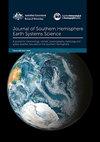Interdecadal modulation of the effect of ENSO on rainfall in the southwestern Pacific
IF 3.6
4区 地球科学
Q1 Earth and Planetary Sciences
引用次数: 5
Abstract
The El Niño-Southern Oscillation (ENSO) is the dominant driver of interannual variability on rainfall in many Pacific Islands and in countries bordering the tropical Pacific Ocean. From 1916 through to 1975, the correlation coefficient between the Southern Oscillation Index (SOI) and interannual variability in rainfall in eastern Australia was strong in negative phases of the Interdecadal Pacific Oscillation (IPO) but weak in positive phases. By examining records of rainfall over the past hundred years in central Vanuatu and on the ‘dry side’ of Fiji, which both lie near the southern edge of the South Pacific Convergence Zone (SPCZ), we find that such modulation by IPO has been much weaker there than in eastern Australia. This paper examines possible reasons for this difference. We also find that the correlation between rainfall and the SOI remained strong throughout each of the past three phases of the IPO, in all these places, including eastern Australia. However, at Rarotonga in the southern Cook Islands, whose position is also near the southern edge of the SPCZ, but at the southeastern end, the displacement of the SPCZ by ENSO events is greater there than further west. Consequently, the correlation between rainfall and SOI is so strong at Rarotonga in El Niño years with SOI<−5 that SOI alone becomes a good predictor of wet-season rainfall there. The difference in modulation of rainfall in eastern Australia between the two positive phases of IPO (1926–1941 and 1978–1998) may be due to the influence on Australia of other climatic oscillations, such as the Indian Ocean Dipole, though other factors may also have played a role.ENSO对西南太平洋降水影响的年代际调制
厄尔Niño-Southern涛动(ENSO)是许多太平洋岛屿和热带太平洋沿岸国家降雨年际变化的主要驱动因素。1916 ~ 1975年,南方涛动指数(SOI)与澳大利亚东部降水年际变率的相关系数在年代际太平洋涛动(IPO)负期较强,而在正期较弱。通过检查瓦努阿图中部和斐济“干燥的一侧”过去100年的降雨记录,这两个地区都位于南太平洋辐合带(SPCZ)的南部边缘附近,我们发现这种IPO调制在那里比在澳大利亚东部弱得多。本文探讨了造成这种差异的可能原因。我们还发现,在所有这些地方,包括澳大利亚东部,在IPO的过去三个阶段中,降雨量和SOI之间的相关性仍然很强。然而,在库克群岛南部的拉罗汤加岛,其位置也接近SPCZ的南缘,但在东南端,ENSO事件对SPCZ的位移比更西的地方更大。因此,在El Niño年,当SOI< - 5时,raarotonga的降雨量与SOI之间的相关性非常强,因此仅SOI就可以很好地预测那里的雨季降雨量。在IPO的两个正相位(1926-1941年和1978-1998年)之间,澳大利亚东部降雨调制的差异可能是由于印度洋偶极子等其他气候振荡对澳大利亚的影响,尽管其他因素也可能发挥了作用。
本文章由计算机程序翻译,如有差异,请以英文原文为准。
求助全文
约1分钟内获得全文
求助全文
来源期刊

Journal of Southern Hemisphere Earth Systems Science
Earth and Planetary Sciences-Oceanography
CiteScore
8.10
自引率
8.30%
发文量
0
审稿时长
>12 weeks
期刊介绍:
The Journal of Southern Hemisphere Earth Systems Science (JSHESS) publishes broad areas of research with a distinct emphasis on the Southern Hemisphere. The scope of the Journal encompasses the study of the mean state, variability and change of the atmosphere, oceans, and land surface, including the cryosphere, from hemispheric to regional scales.
general circulation of the atmosphere and oceans,
climate change and variability ,
climate impacts,
climate modelling ,
past change in the climate system including palaeoclimate variability,
atmospheric dynamics,
synoptic meteorology,
mesoscale meteorology and severe weather,
tropical meteorology,
observation systems,
remote sensing of atmospheric, oceanic and land surface processes,
weather, climate and ocean prediction,
atmospheric and oceanic composition and chemistry,
physical oceanography,
air‐sea interactions,
coastal zone processes,
hydrology,
cryosphere‐atmosphere interactions,
land surface‐atmosphere interactions,
space weather, including impacts and mitigation on technology,
ionospheric, magnetospheric, auroral and space physics,
data assimilation applied to the above subject areas .
Authors are encouraged to contact the Editor for specific advice on whether the subject matter of a proposed submission is appropriate for the Journal of Southern Hemisphere Earth Systems Science.
 求助内容:
求助内容: 应助结果提醒方式:
应助结果提醒方式:


